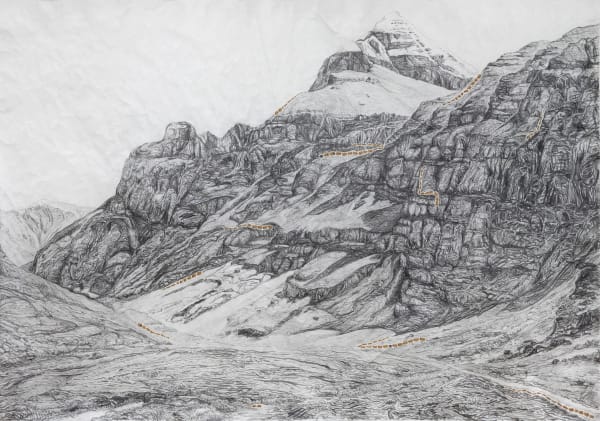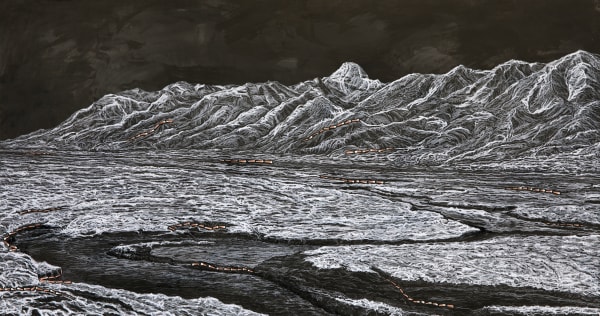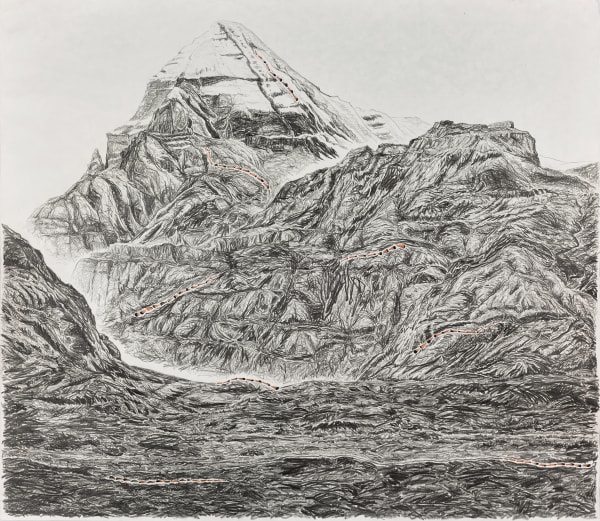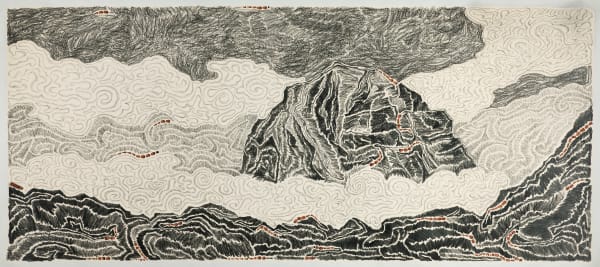Mount Kailash is in the west of Tibet, at a height of 6,638 meters. The peak is covered by snow all year round, and is spectacular both visually and spiritually. The great rivers of the world such as the Ganges River, the Indian River, and the Brahmaputra River all originate from the mountain. It is also regarded as a sacred mountain and where deities reside by Tibetan Buddhism, Hinduism, Tibetan Bon religion and Jainism. Devout Tibetan Buddhists hike around the mountain in a clock-wise direction, hoping to purify their negative karma in this and previous lifes, and to accumulate immeasurable merit.
One of the series in "Pen Walking" is to draw the Mount Kailash with a pencil, while using up the entire pencil in the process. Here, I adopted the story of *I Try*. To me, the mountain was a symbol, representing a goal that is transcended in reincarnation. As I could not physically reach the mountain, I used the sheet of paper as my shrine. Walking around a place or object is a kind of ritual as well as a kind of practice in Buddhism. It is often performed around a noble one or a symbol of respect, such as a Buddha statue, or a Stupa. Walking clock-wise represents following Buddha Dharma and also putting one’s heart and soul into Dharma. “Pen walking” (using up the entire pencil to draw the mountain) the mountain sets me under a different altitude, which lets me see from above all life experiences. It also reminds me that this is a journey with a destination at the end. This kind of concentrated and repeated behavior also brings me peace and calmness.
The life of a pencil devoted to walking around a mountain is a beautiful story. With continues lines and pencil shavings, we see a pencil devote its life to walking around a mountain. This represents devoting one’s life to climbing a mountain. If the goal is not achieved in this life, then one would continue in the next life (or pencil). If one still cannot reach the goal, then one would try again and again. As long as a person holds the fundamental motivation to do so, one will find truth, wisdom and compassion, eventually.
岡仁波齊峰,位於西藏西部,海拔6,638米,峰頂終年積雪,山勢威凜,極具心靈和視覺震撼力。恒河、印度河、布拉馬普特拉河等大江大河均發源於此,它同時被藏傳佛教、印度教、西藏原生宗教苯教,以及耆那教認為是天人與諸神所居的聖山。來自印度、尼泊爾、不丹以及西藏的朝聖人們絡繹不絕,篤信佛教的藏人堅信以順時鐘的方向繞山,能夠滌盡前世今生的罪孽,累積無量的功德。
《走筆》有一系列作品,是以一枝鉛筆走畫出岡仁波齊峰,在這裡我認養了《我試著》裡面爬山的故事。對我而言,這座山是個象徵,代表自輪迴生命中超越的一個目標。我的身體到不了那裡,就用這一方紙做為我朝聖的道場。繞行這個行為,在佛教是個敬禮也是修行,以尊者或崇敬的象徵物,如佛像、佛塔為中心繞行,向右繞行則是表達順於佛法之意,它同時象徵念茲在茲都在於此。事實上,走筆轉山讓我有一個高度,俯瞰所有人生的經歷,提醒我這是一個有目標的旅途,而這個專注與重複的行為,帶給我內心的平靜與安定。
鉛筆的一生完全奉獻繞行一座山,本身就很美。以連續不中斷的線條與鉛筆屑,耗盡一枝鉛筆的走筆轉山,是指以一期的生命來爬這座山,如果沒有達成,就在下一個生命(鉛筆)繼續爬山。如果一輩子做不成,就下輩子再來,再不成就再繼續,只要有一個根本的願力,總有一天我會面對真理、智慧與慈悲。
One of the series in "Pen Walking" is to draw the Mount Kailash with a pencil, while using up the entire pencil in the process. Here, I adopted the story of *I Try*. To me, the mountain was a symbol, representing a goal that is transcended in reincarnation. As I could not physically reach the mountain, I used the sheet of paper as my shrine. Walking around a place or object is a kind of ritual as well as a kind of practice in Buddhism. It is often performed around a noble one or a symbol of respect, such as a Buddha statue, or a Stupa. Walking clock-wise represents following Buddha Dharma and also putting one’s heart and soul into Dharma. “Pen walking” (using up the entire pencil to draw the mountain) the mountain sets me under a different altitude, which lets me see from above all life experiences. It also reminds me that this is a journey with a destination at the end. This kind of concentrated and repeated behavior also brings me peace and calmness.
The life of a pencil devoted to walking around a mountain is a beautiful story. With continues lines and pencil shavings, we see a pencil devote its life to walking around a mountain. This represents devoting one’s life to climbing a mountain. If the goal is not achieved in this life, then one would continue in the next life (or pencil). If one still cannot reach the goal, then one would try again and again. As long as a person holds the fundamental motivation to do so, one will find truth, wisdom and compassion, eventually.
岡仁波齊峰,位於西藏西部,海拔6,638米,峰頂終年積雪,山勢威凜,極具心靈和視覺震撼力。恒河、印度河、布拉馬普特拉河等大江大河均發源於此,它同時被藏傳佛教、印度教、西藏原生宗教苯教,以及耆那教認為是天人與諸神所居的聖山。來自印度、尼泊爾、不丹以及西藏的朝聖人們絡繹不絕,篤信佛教的藏人堅信以順時鐘的方向繞山,能夠滌盡前世今生的罪孽,累積無量的功德。
《走筆》有一系列作品,是以一枝鉛筆走畫出岡仁波齊峰,在這裡我認養了《我試著》裡面爬山的故事。對我而言,這座山是個象徵,代表自輪迴生命中超越的一個目標。我的身體到不了那裡,就用這一方紙做為我朝聖的道場。繞行這個行為,在佛教是個敬禮也是修行,以尊者或崇敬的象徵物,如佛像、佛塔為中心繞行,向右繞行則是表達順於佛法之意,它同時象徵念茲在茲都在於此。事實上,走筆轉山讓我有一個高度,俯瞰所有人生的經歷,提醒我這是一個有目標的旅途,而這個專注與重複的行為,帶給我內心的平靜與安定。
鉛筆的一生完全奉獻繞行一座山,本身就很美。以連續不中斷的線條與鉛筆屑,耗盡一枝鉛筆的走筆轉山,是指以一期的生命來爬這座山,如果沒有達成,就在下一個生命(鉛筆)繼續爬山。如果一輩子做不成,就下輩子再來,再不成就再繼續,只要有一個根本的願力,總有一天我會面對真理、智慧與慈悲。
-
 Pen Walking #185, 2018-2024
Pen Walking #185, 2018-2024 -
 Pen Walking #184, 2021-2023
Pen Walking #184, 2021-2023 -
 Pen Walking #183 The Tranquil Peak and Serene Ridges, 2022
Pen Walking #183 The Tranquil Peak and Serene Ridges, 2022 -
 Pen Walking #181, 2021-2022
Pen Walking #181, 2021-2022 -
 Pen Walking #180, 2015-2022
Pen Walking #180, 2015-2022 -
 Pen Walking #179 Seeing Compassion Lake Around Mount Kailash, 2021-2022
Pen Walking #179 Seeing Compassion Lake Around Mount Kailash, 2021-2022 -
 Pen Walking #178 Moon above Mount Kailash at Dawn, 2019-2021
Pen Walking #178 Moon above Mount Kailash at Dawn, 2019-2021 -
 Pen Walking #176, 2020-2021
Pen Walking #176, 2020-2021 -
 Pen Walking #173 The Picture of Unclouded Moon and Blowing Snow, 2019-2020
Pen Walking #173 The Picture of Unclouded Moon and Blowing Snow, 2019-2020 -
 Pen Walking #169 Moonlight over Mount Kailash, 2019
Pen Walking #169 Moonlight over Mount Kailash, 2019 -
 Pen Walking #168, 2018-2019
Pen Walking #168, 2018-2019 -
 Pen Walking #165, 2017
Pen Walking #165, 2017 -
 Pen Walking #163, 2012-2016
Pen Walking #163, 2012-2016 -
 Pen Walking #161, 2016
Pen Walking #161, 2016 -
 Pen Walking #160, 2016-2017
Pen Walking #160, 2016-2017 -
 Pen Walking #144, 2015
Pen Walking #144, 2015 -
 Pen Walking #136, 2014
Pen Walking #136, 2014 -
 Pen Walking #125, 2012
Pen Walking #125, 2012 -
 Pen Walking #120, 2012
Pen Walking #120, 2012 -
 Pen Walking #112, 2011
Pen Walking #112, 2011 -
 Pen Walking #110, 2011
Pen Walking #110, 2011 -
 Pen Walking #108, 2011
Pen Walking #108, 2011 -
 Pen Walking #99, 2011
Pen Walking #99, 2011 -
 Pen Walking #51, 2008
Pen Walking #51, 2008























